A Comprehensive Analysis of Diversity and Inclusion in Education
VerifiedAdded on 2023/06/07
|12
|3630
|256
Homework Assignment
AI Summary
This assignment provides a comprehensive overview of diversity and inclusion in education, focusing on early childhood settings. It addresses key concepts such as cultural safety, ethical considerations, and the importance of creating inclusive classrooms. The assignment explores various facets of diversity, including cultural, religious, and racial diversity, and discusses how these elements impact the learning environment. It also examines the role of educators in promoting inclusivity and respecting the diverse backgrounds of students. Furthermore, the assignment delves into practical strategies for fostering cultural diversity and offers insights into the challenges and opportunities associated with educating children from diverse backgrounds. The importance of parental involvement and community consultation in promoting inclusivity is also highlighted. Desklib offers additional resources and study tools for students to further explore these topics.
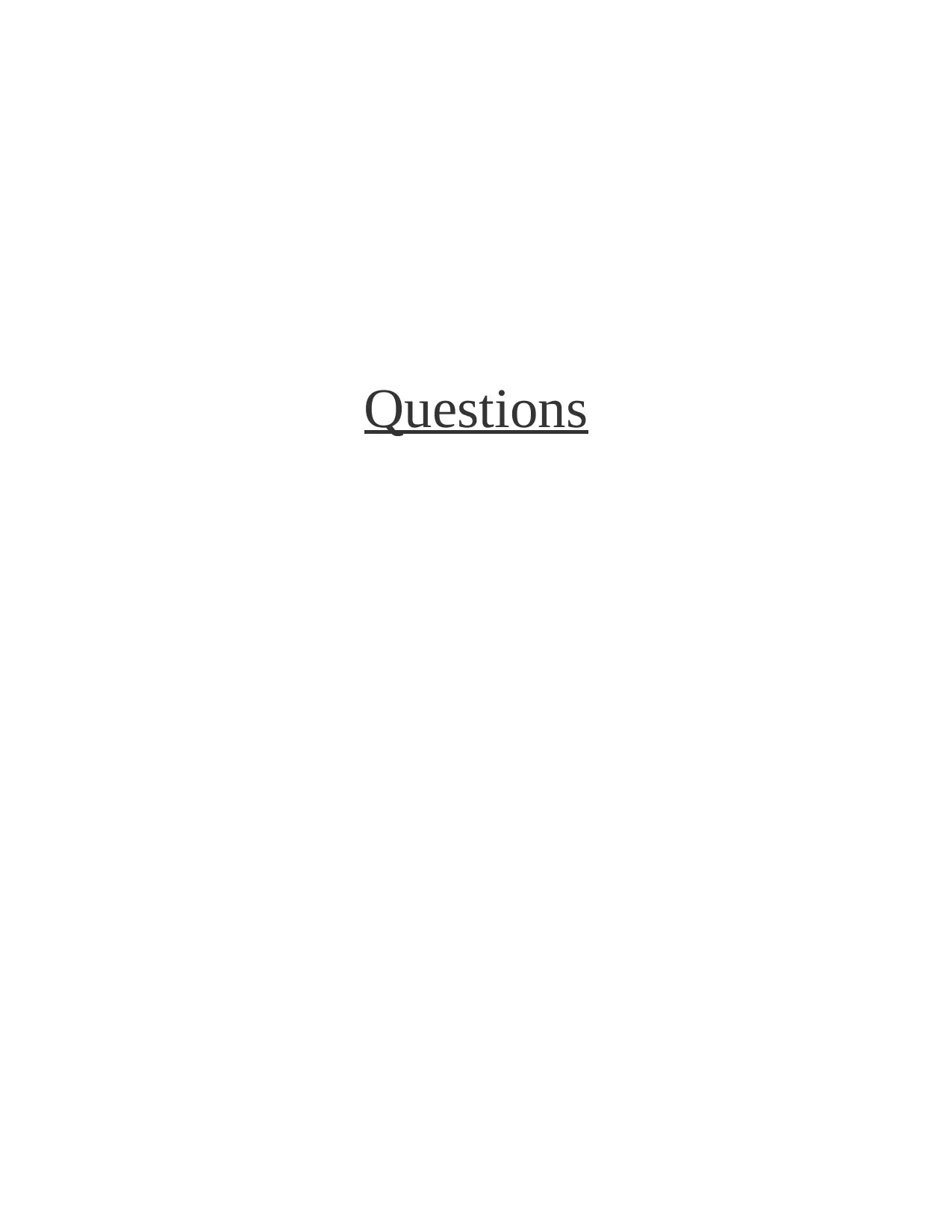
Questions
Paraphrase This Document
Need a fresh take? Get an instant paraphrase of this document with our AI Paraphraser
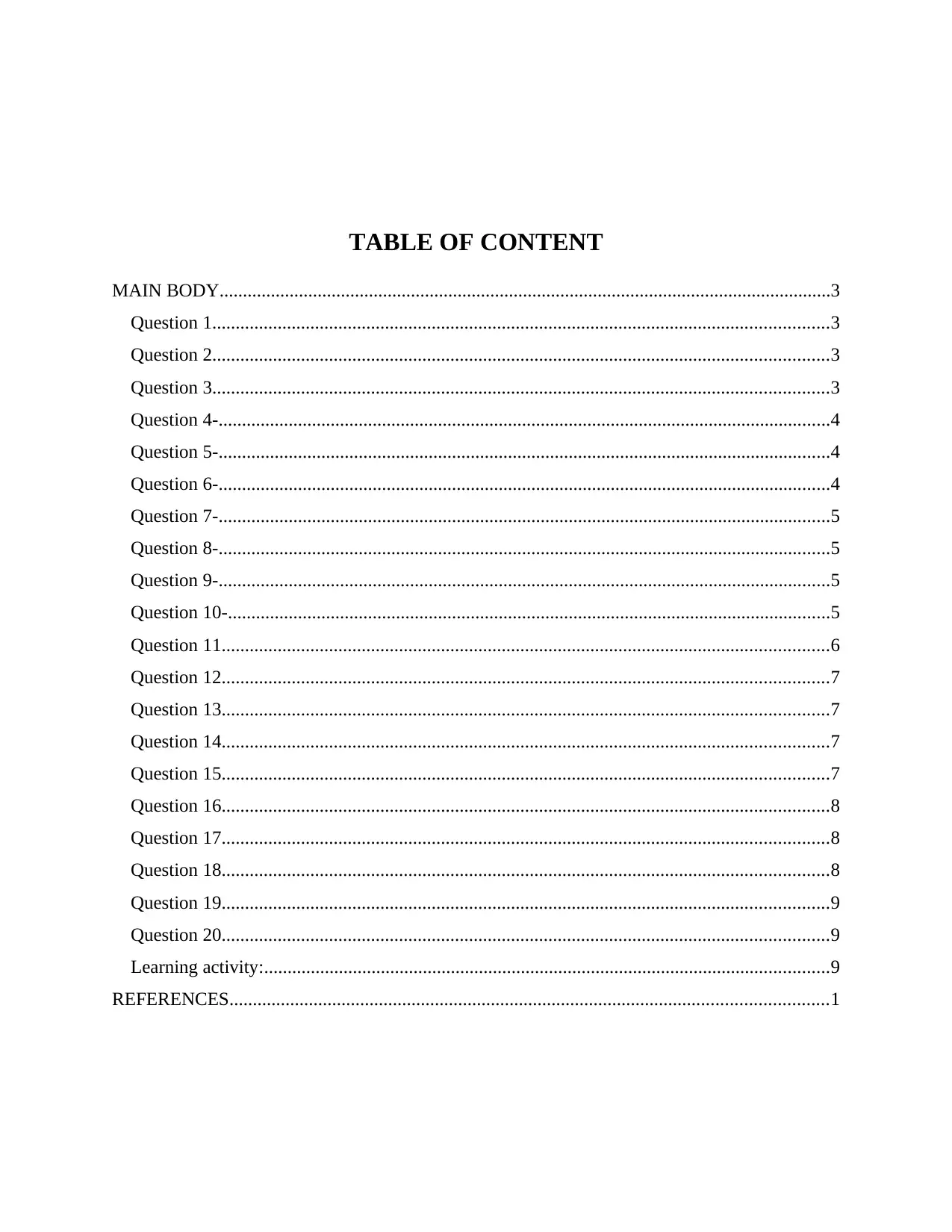
TABLE OF CONTENT
MAIN BODY...................................................................................................................................3
Question 1....................................................................................................................................3
Question 2....................................................................................................................................3
Question 3....................................................................................................................................3
Question 4-...................................................................................................................................4
Question 5-...................................................................................................................................4
Question 6-...................................................................................................................................4
Question 7-...................................................................................................................................5
Question 8-...................................................................................................................................5
Question 9-...................................................................................................................................5
Question 10-.................................................................................................................................5
Question 11..................................................................................................................................6
Question 12..................................................................................................................................7
Question 13..................................................................................................................................7
Question 14..................................................................................................................................7
Question 15..................................................................................................................................7
Question 16..................................................................................................................................8
Question 17..................................................................................................................................8
Question 18..................................................................................................................................8
Question 19..................................................................................................................................9
Question 20..................................................................................................................................9
Learning activity:.........................................................................................................................9
REFERENCES................................................................................................................................1
MAIN BODY...................................................................................................................................3
Question 1....................................................................................................................................3
Question 2....................................................................................................................................3
Question 3....................................................................................................................................3
Question 4-...................................................................................................................................4
Question 5-...................................................................................................................................4
Question 6-...................................................................................................................................4
Question 7-...................................................................................................................................5
Question 8-...................................................................................................................................5
Question 9-...................................................................................................................................5
Question 10-.................................................................................................................................5
Question 11..................................................................................................................................6
Question 12..................................................................................................................................7
Question 13..................................................................................................................................7
Question 14..................................................................................................................................7
Question 15..................................................................................................................................7
Question 16..................................................................................................................................8
Question 17..................................................................................................................................8
Question 18..................................................................................................................................8
Question 19..................................................................................................................................9
Question 20..................................................................................................................................9
Learning activity:.........................................................................................................................9
REFERENCES................................................................................................................................1
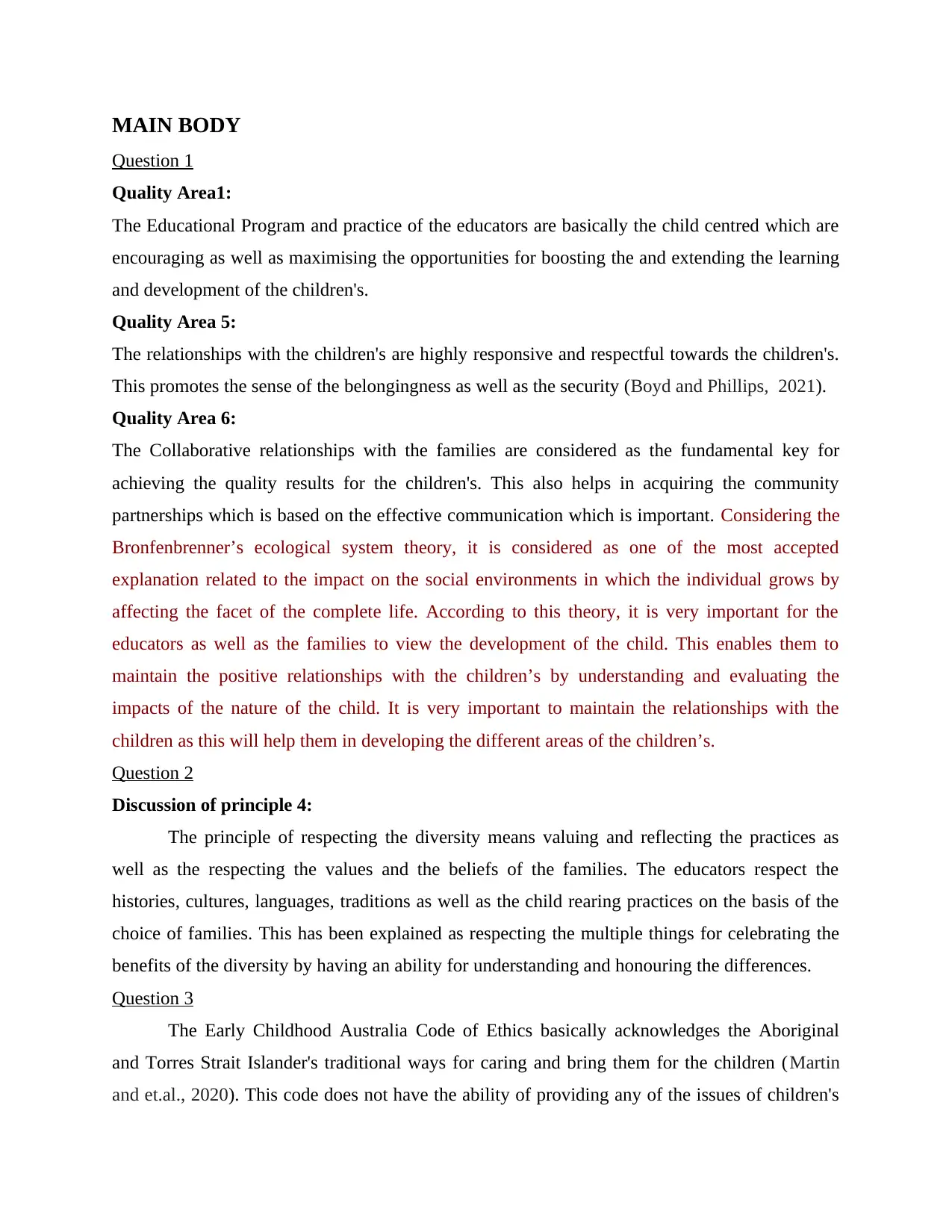
MAIN BODY
Question 1
Quality Area1:
The Educational Program and practice of the educators are basically the child centred which are
encouraging as well as maximising the opportunities for boosting the and extending the learning
and development of the children's.
Quality Area 5:
The relationships with the children's are highly responsive and respectful towards the children's.
This promotes the sense of the belongingness as well as the security (Boyd and Phillips, 2021).
Quality Area 6:
The Collaborative relationships with the families are considered as the fundamental key for
achieving the quality results for the children's. This also helps in acquiring the community
partnerships which is based on the effective communication which is important. Considering the
Bronfenbrenner’s ecological system theory, it is considered as one of the most accepted
explanation related to the impact on the social environments in which the individual grows by
affecting the facet of the complete life. According to this theory, it is very important for the
educators as well as the families to view the development of the child. This enables them to
maintain the positive relationships with the children’s by understanding and evaluating the
impacts of the nature of the child. It is very important to maintain the relationships with the
children as this will help them in developing the different areas of the children’s.
Question 2
Discussion of principle 4:
The principle of respecting the diversity means valuing and reflecting the practices as
well as the respecting the values and the beliefs of the families. The educators respect the
histories, cultures, languages, traditions as well as the child rearing practices on the basis of the
choice of families. This has been explained as respecting the multiple things for celebrating the
benefits of the diversity by having an ability for understanding and honouring the differences.
Question 3
The Early Childhood Australia Code of Ethics basically acknowledges the Aboriginal
and Torres Strait Islander's traditional ways for caring and bring them for the children (Martin
and et.al., 2020). This code does not have the ability of providing any of the issues of children's
Question 1
Quality Area1:
The Educational Program and practice of the educators are basically the child centred which are
encouraging as well as maximising the opportunities for boosting the and extending the learning
and development of the children's.
Quality Area 5:
The relationships with the children's are highly responsive and respectful towards the children's.
This promotes the sense of the belongingness as well as the security (Boyd and Phillips, 2021).
Quality Area 6:
The Collaborative relationships with the families are considered as the fundamental key for
achieving the quality results for the children's. This also helps in acquiring the community
partnerships which is based on the effective communication which is important. Considering the
Bronfenbrenner’s ecological system theory, it is considered as one of the most accepted
explanation related to the impact on the social environments in which the individual grows by
affecting the facet of the complete life. According to this theory, it is very important for the
educators as well as the families to view the development of the child. This enables them to
maintain the positive relationships with the children’s by understanding and evaluating the
impacts of the nature of the child. It is very important to maintain the relationships with the
children as this will help them in developing the different areas of the children’s.
Question 2
Discussion of principle 4:
The principle of respecting the diversity means valuing and reflecting the practices as
well as the respecting the values and the beliefs of the families. The educators respect the
histories, cultures, languages, traditions as well as the child rearing practices on the basis of the
choice of families. This has been explained as respecting the multiple things for celebrating the
benefits of the diversity by having an ability for understanding and honouring the differences.
Question 3
The Early Childhood Australia Code of Ethics basically acknowledges the Aboriginal
and Torres Strait Islander's traditional ways for caring and bring them for the children (Martin
and et.al., 2020). This code does not have the ability of providing any of the issues of children's
⊘ This is a preview!⊘
Do you want full access?
Subscribe today to unlock all pages.

Trusted by 1+ million students worldwide
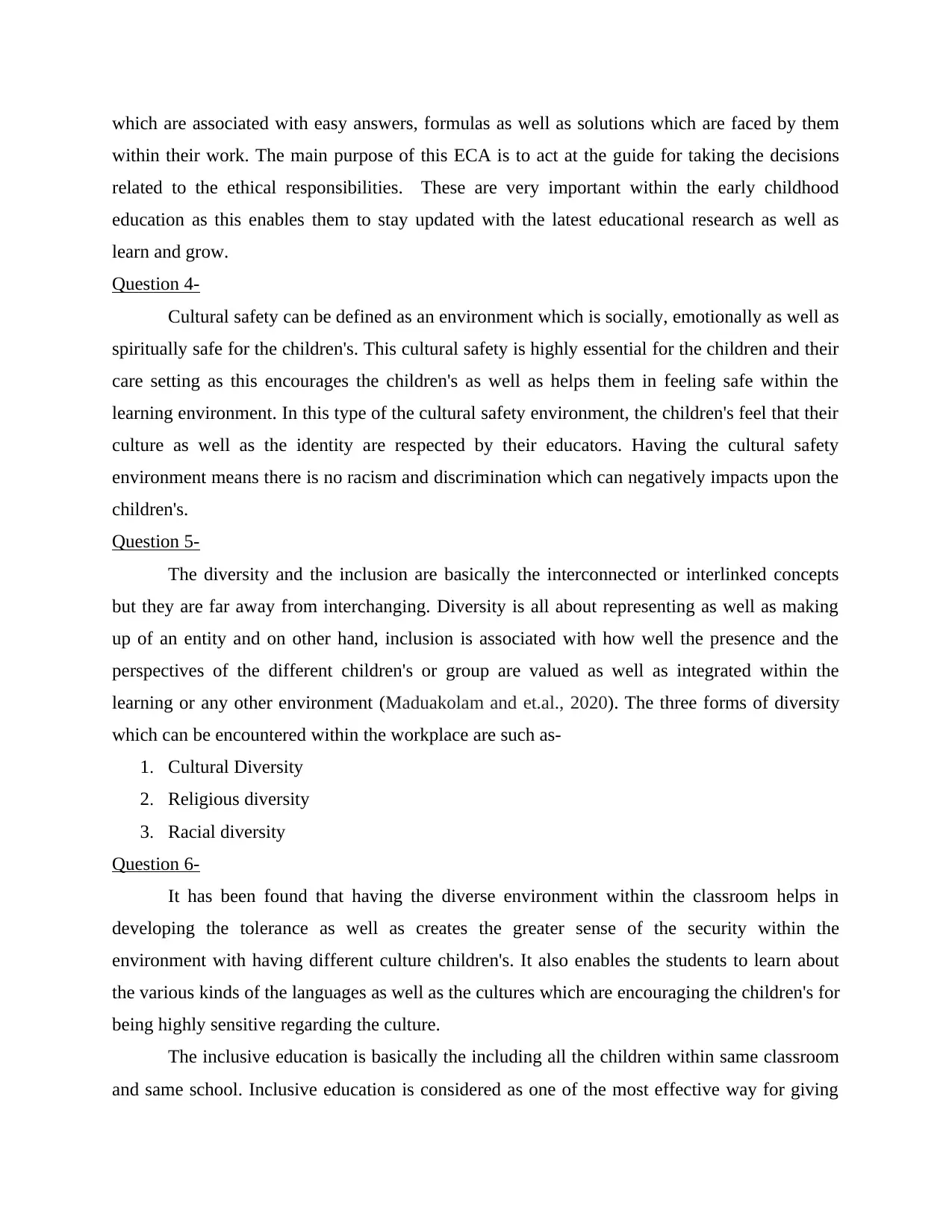
which are associated with easy answers, formulas as well as solutions which are faced by them
within their work. The main purpose of this ECA is to act at the guide for taking the decisions
related to the ethical responsibilities. These are very important within the early childhood
education as this enables them to stay updated with the latest educational research as well as
learn and grow.
Question 4-
Cultural safety can be defined as an environment which is socially, emotionally as well as
spiritually safe for the children's. This cultural safety is highly essential for the children and their
care setting as this encourages the children's as well as helps them in feeling safe within the
learning environment. In this type of the cultural safety environment, the children's feel that their
culture as well as the identity are respected by their educators. Having the cultural safety
environment means there is no racism and discrimination which can negatively impacts upon the
children's.
Question 5-
The diversity and the inclusion are basically the interconnected or interlinked concepts
but they are far away from interchanging. Diversity is all about representing as well as making
up of an entity and on other hand, inclusion is associated with how well the presence and the
perspectives of the different children's or group are valued as well as integrated within the
learning or any other environment (Maduakolam and et.al., 2020). The three forms of diversity
which can be encountered within the workplace are such as-
1. Cultural Diversity
2. Religious diversity
3. Racial diversity
Question 6-
It has been found that having the diverse environment within the classroom helps in
developing the tolerance as well as creates the greater sense of the security within the
environment with having different culture children's. It also enables the students to learn about
the various kinds of the languages as well as the cultures which are encouraging the children's for
being highly sensitive regarding the culture.
The inclusive education is basically the including all the children within same classroom
and same school. Inclusive education is considered as one of the most effective way for giving
within their work. The main purpose of this ECA is to act at the guide for taking the decisions
related to the ethical responsibilities. These are very important within the early childhood
education as this enables them to stay updated with the latest educational research as well as
learn and grow.
Question 4-
Cultural safety can be defined as an environment which is socially, emotionally as well as
spiritually safe for the children's. This cultural safety is highly essential for the children and their
care setting as this encourages the children's as well as helps them in feeling safe within the
learning environment. In this type of the cultural safety environment, the children's feel that their
culture as well as the identity are respected by their educators. Having the cultural safety
environment means there is no racism and discrimination which can negatively impacts upon the
children's.
Question 5-
The diversity and the inclusion are basically the interconnected or interlinked concepts
but they are far away from interchanging. Diversity is all about representing as well as making
up of an entity and on other hand, inclusion is associated with how well the presence and the
perspectives of the different children's or group are valued as well as integrated within the
learning or any other environment (Maduakolam and et.al., 2020). The three forms of diversity
which can be encountered within the workplace are such as-
1. Cultural Diversity
2. Religious diversity
3. Racial diversity
Question 6-
It has been found that having the diverse environment within the classroom helps in
developing the tolerance as well as creates the greater sense of the security within the
environment with having different culture children's. It also enables the students to learn about
the various kinds of the languages as well as the cultures which are encouraging the children's for
being highly sensitive regarding the culture.
The inclusive education is basically the including all the children within same classroom
and same school. Inclusive education is considered as one of the most effective way for giving
Paraphrase This Document
Need a fresh take? Get an instant paraphrase of this document with our AI Paraphraser
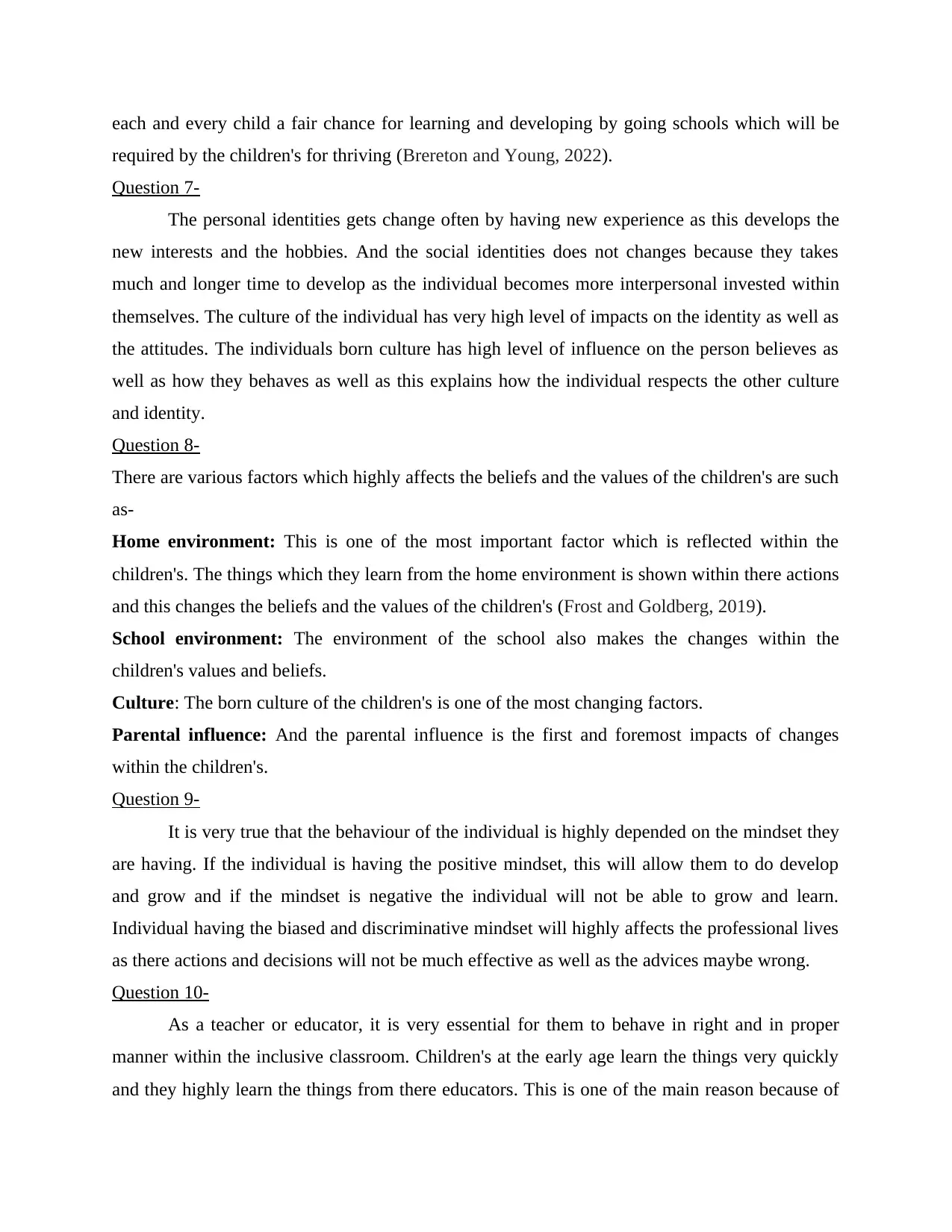
each and every child a fair chance for learning and developing by going schools which will be
required by the children's for thriving (Brereton and Young, 2022).
Question 7-
The personal identities gets change often by having new experience as this develops the
new interests and the hobbies. And the social identities does not changes because they takes
much and longer time to develop as the individual becomes more interpersonal invested within
themselves. The culture of the individual has very high level of impacts on the identity as well as
the attitudes. The individuals born culture has high level of influence on the person believes as
well as how they behaves as well as this explains how the individual respects the other culture
and identity.
Question 8-
There are various factors which highly affects the beliefs and the values of the children's are such
as-
Home environment: This is one of the most important factor which is reflected within the
children's. The things which they learn from the home environment is shown within there actions
and this changes the beliefs and the values of the children's (Frost and Goldberg, 2019).
School environment: The environment of the school also makes the changes within the
children's values and beliefs.
Culture: The born culture of the children's is one of the most changing factors.
Parental influence: And the parental influence is the first and foremost impacts of changes
within the children's.
Question 9-
It is very true that the behaviour of the individual is highly depended on the mindset they
are having. If the individual is having the positive mindset, this will allow them to do develop
and grow and if the mindset is negative the individual will not be able to grow and learn.
Individual having the biased and discriminative mindset will highly affects the professional lives
as there actions and decisions will not be much effective as well as the advices maybe wrong.
Question 10-
As a teacher or educator, it is very essential for them to behave in right and in proper
manner within the inclusive classroom. Children's at the early age learn the things very quickly
and they highly learn the things from there educators. This is one of the main reason because of
required by the children's for thriving (Brereton and Young, 2022).
Question 7-
The personal identities gets change often by having new experience as this develops the
new interests and the hobbies. And the social identities does not changes because they takes
much and longer time to develop as the individual becomes more interpersonal invested within
themselves. The culture of the individual has very high level of impacts on the identity as well as
the attitudes. The individuals born culture has high level of influence on the person believes as
well as how they behaves as well as this explains how the individual respects the other culture
and identity.
Question 8-
There are various factors which highly affects the beliefs and the values of the children's are such
as-
Home environment: This is one of the most important factor which is reflected within the
children's. The things which they learn from the home environment is shown within there actions
and this changes the beliefs and the values of the children's (Frost and Goldberg, 2019).
School environment: The environment of the school also makes the changes within the
children's values and beliefs.
Culture: The born culture of the children's is one of the most changing factors.
Parental influence: And the parental influence is the first and foremost impacts of changes
within the children's.
Question 9-
It is very true that the behaviour of the individual is highly depended on the mindset they
are having. If the individual is having the positive mindset, this will allow them to do develop
and grow and if the mindset is negative the individual will not be able to grow and learn.
Individual having the biased and discriminative mindset will highly affects the professional lives
as there actions and decisions will not be much effective as well as the advices maybe wrong.
Question 10-
As a teacher or educator, it is very essential for them to behave in right and in proper
manner within the inclusive classroom. Children's at the early age learn the things very quickly
and they highly learn the things from there educators. This is one of the main reason because of
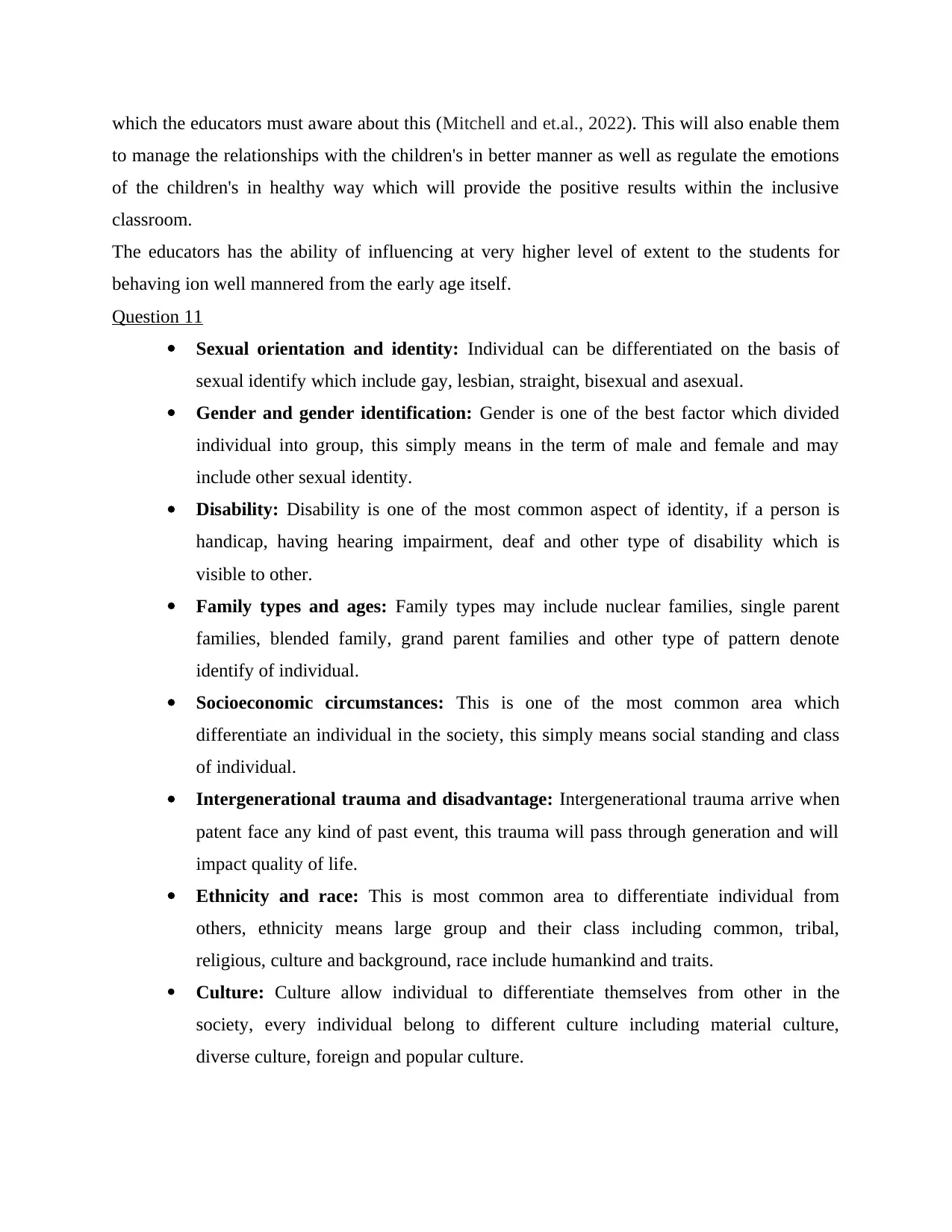
which the educators must aware about this (Mitchell and et.al., 2022). This will also enable them
to manage the relationships with the children's in better manner as well as regulate the emotions
of the children's in healthy way which will provide the positive results within the inclusive
classroom.
The educators has the ability of influencing at very higher level of extent to the students for
behaving ion well mannered from the early age itself.
Question 11
Sexual orientation and identity: Individual can be differentiated on the basis of
sexual identify which include gay, lesbian, straight, bisexual and asexual.
Gender and gender identification: Gender is one of the best factor which divided
individual into group, this simply means in the term of male and female and may
include other sexual identity.
Disability: Disability is one of the most common aspect of identity, if a person is
handicap, having hearing impairment, deaf and other type of disability which is
visible to other.
Family types and ages: Family types may include nuclear families, single parent
families, blended family, grand parent families and other type of pattern denote
identify of individual.
Socioeconomic circumstances: This is one of the most common area which
differentiate an individual in the society, this simply means social standing and class
of individual.
Intergenerational trauma and disadvantage: Intergenerational trauma arrive when
patent face any kind of past event, this trauma will pass through generation and will
impact quality of life.
Ethnicity and race: This is most common area to differentiate individual from
others, ethnicity means large group and their class including common, tribal,
religious, culture and background, race include humankind and traits.
Culture: Culture allow individual to differentiate themselves from other in the
society, every individual belong to different culture including material culture,
diverse culture, foreign and popular culture.
to manage the relationships with the children's in better manner as well as regulate the emotions
of the children's in healthy way which will provide the positive results within the inclusive
classroom.
The educators has the ability of influencing at very higher level of extent to the students for
behaving ion well mannered from the early age itself.
Question 11
Sexual orientation and identity: Individual can be differentiated on the basis of
sexual identify which include gay, lesbian, straight, bisexual and asexual.
Gender and gender identification: Gender is one of the best factor which divided
individual into group, this simply means in the term of male and female and may
include other sexual identity.
Disability: Disability is one of the most common aspect of identity, if a person is
handicap, having hearing impairment, deaf and other type of disability which is
visible to other.
Family types and ages: Family types may include nuclear families, single parent
families, blended family, grand parent families and other type of pattern denote
identify of individual.
Socioeconomic circumstances: This is one of the most common area which
differentiate an individual in the society, this simply means social standing and class
of individual.
Intergenerational trauma and disadvantage: Intergenerational trauma arrive when
patent face any kind of past event, this trauma will pass through generation and will
impact quality of life.
Ethnicity and race: This is most common area to differentiate individual from
others, ethnicity means large group and their class including common, tribal,
religious, culture and background, race include humankind and traits.
Culture: Culture allow individual to differentiate themselves from other in the
society, every individual belong to different culture including material culture,
diverse culture, foreign and popular culture.
⊘ This is a preview!⊘
Do you want full access?
Subscribe today to unlock all pages.

Trusted by 1+ million students worldwide
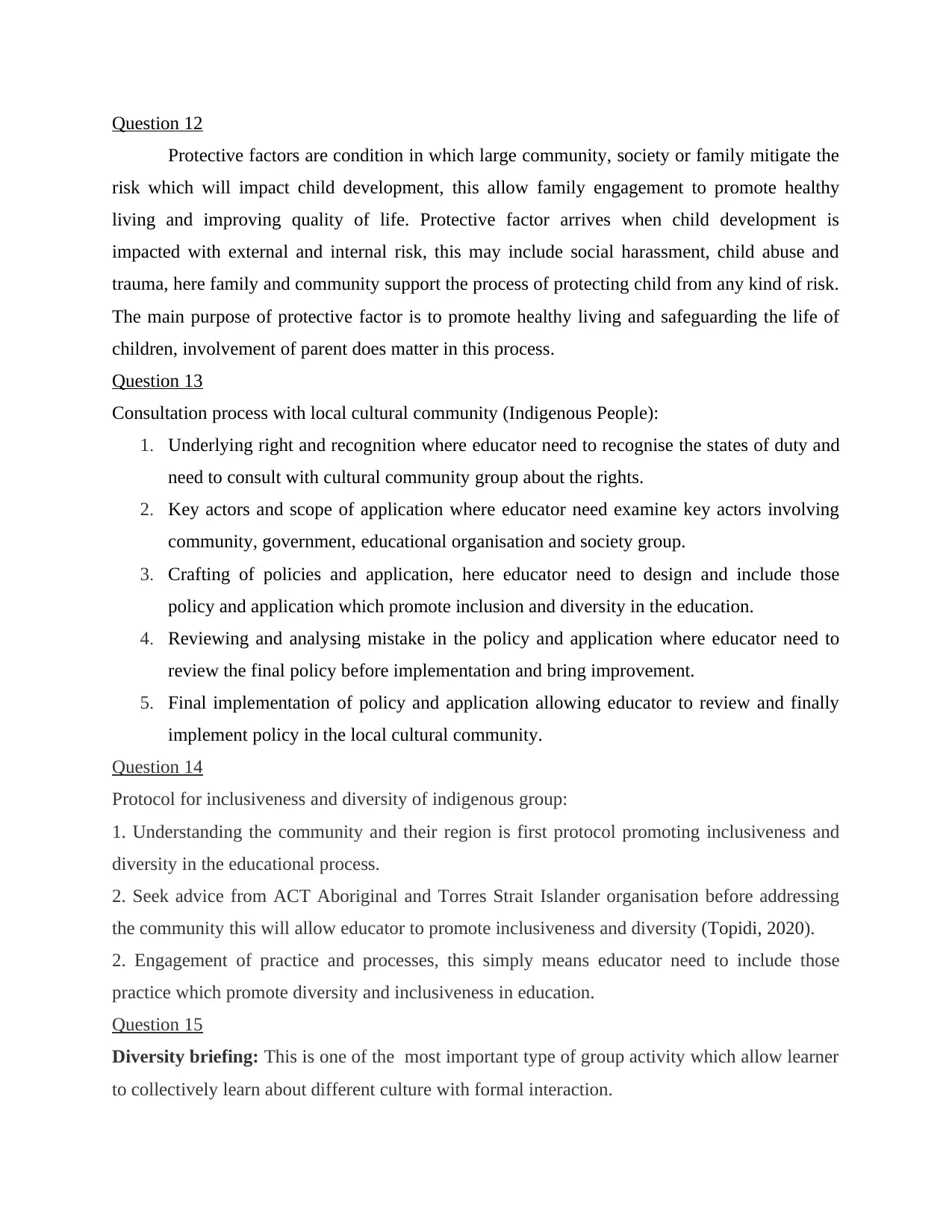
Question 12
Protective factors are condition in which large community, society or family mitigate the
risk which will impact child development, this allow family engagement to promote healthy
living and improving quality of life. Protective factor arrives when child development is
impacted with external and internal risk, this may include social harassment, child abuse and
trauma, here family and community support the process of protecting child from any kind of risk.
The main purpose of protective factor is to promote healthy living and safeguarding the life of
children, involvement of parent does matter in this process.
Question 13
Consultation process with local cultural community (Indigenous People):
1. Underlying right and recognition where educator need to recognise the states of duty and
need to consult with cultural community group about the rights.
2. Key actors and scope of application where educator need examine key actors involving
community, government, educational organisation and society group.
3. Crafting of policies and application, here educator need to design and include those
policy and application which promote inclusion and diversity in the education.
4. Reviewing and analysing mistake in the policy and application where educator need to
review the final policy before implementation and bring improvement.
5. Final implementation of policy and application allowing educator to review and finally
implement policy in the local cultural community.
Question 14
Protocol for inclusiveness and diversity of indigenous group:
1. Understanding the community and their region is first protocol promoting inclusiveness and
diversity in the educational process.
2. Seek advice from ACT Aboriginal and Torres Strait Islander organisation before addressing
the community this will allow educator to promote inclusiveness and diversity (Topidi, 2020).
2. Engagement of practice and processes, this simply means educator need to include those
practice which promote diversity and inclusiveness in education.
Question 15
Diversity briefing: This is one of the most important type of group activity which allow learner
to collectively learn about different culture with formal interaction.
Protective factors are condition in which large community, society or family mitigate the
risk which will impact child development, this allow family engagement to promote healthy
living and improving quality of life. Protective factor arrives when child development is
impacted with external and internal risk, this may include social harassment, child abuse and
trauma, here family and community support the process of protecting child from any kind of risk.
The main purpose of protective factor is to promote healthy living and safeguarding the life of
children, involvement of parent does matter in this process.
Question 13
Consultation process with local cultural community (Indigenous People):
1. Underlying right and recognition where educator need to recognise the states of duty and
need to consult with cultural community group about the rights.
2. Key actors and scope of application where educator need examine key actors involving
community, government, educational organisation and society group.
3. Crafting of policies and application, here educator need to design and include those
policy and application which promote inclusion and diversity in the education.
4. Reviewing and analysing mistake in the policy and application where educator need to
review the final policy before implementation and bring improvement.
5. Final implementation of policy and application allowing educator to review and finally
implement policy in the local cultural community.
Question 14
Protocol for inclusiveness and diversity of indigenous group:
1. Understanding the community and their region is first protocol promoting inclusiveness and
diversity in the educational process.
2. Seek advice from ACT Aboriginal and Torres Strait Islander organisation before addressing
the community this will allow educator to promote inclusiveness and diversity (Topidi, 2020).
2. Engagement of practice and processes, this simply means educator need to include those
practice which promote diversity and inclusiveness in education.
Question 15
Diversity briefing: This is one of the most important type of group activity which allow learner
to collectively learn about different culture with formal interaction.
Paraphrase This Document
Need a fresh take? Get an instant paraphrase of this document with our AI Paraphraser
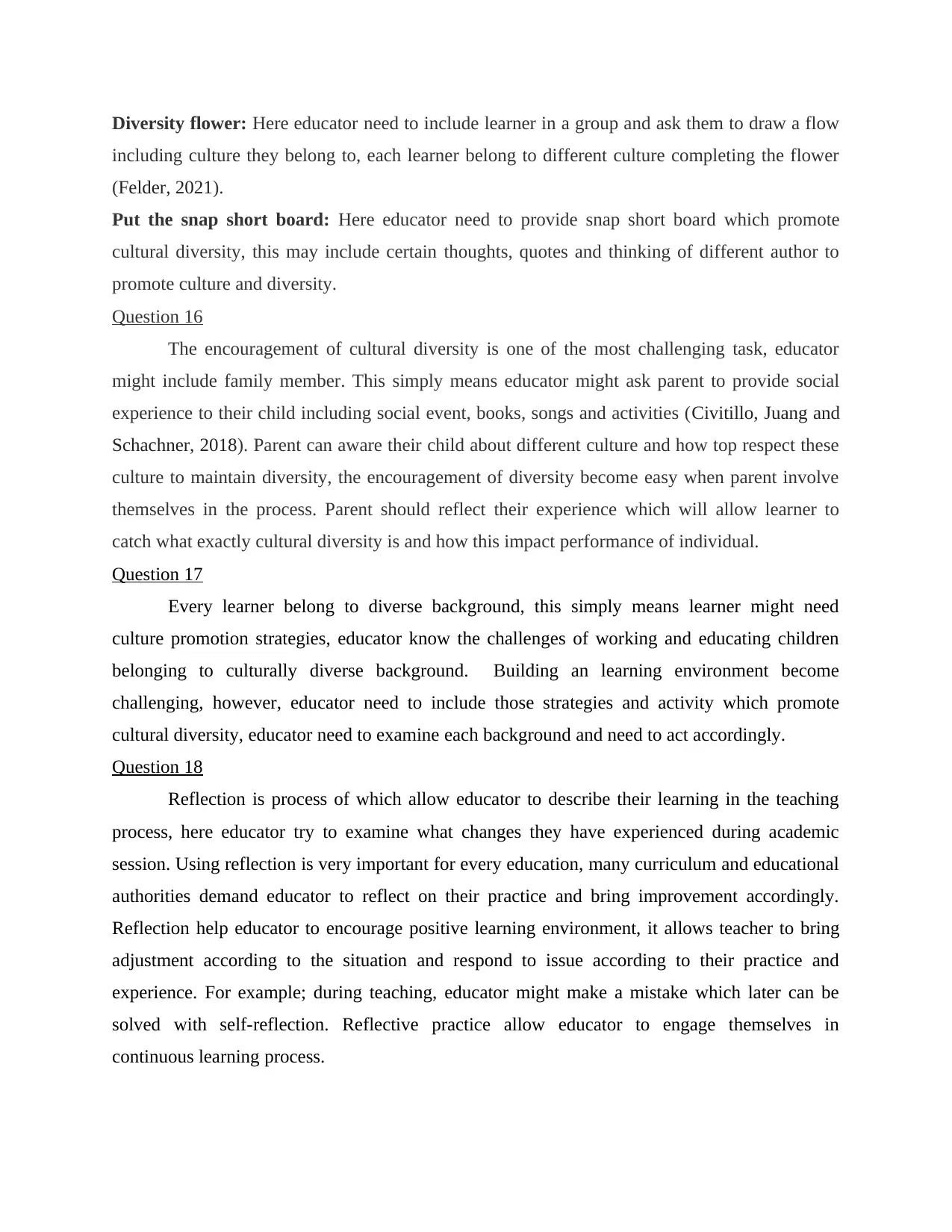
Diversity flower: Here educator need to include learner in a group and ask them to draw a flow
including culture they belong to, each learner belong to different culture completing the flower
(Felder, 2021).
Put the snap short board: Here educator need to provide snap short board which promote
cultural diversity, this may include certain thoughts, quotes and thinking of different author to
promote culture and diversity.
Question 16
The encouragement of cultural diversity is one of the most challenging task, educator
might include family member. This simply means educator might ask parent to provide social
experience to their child including social event, books, songs and activities (Civitillo, Juang and
Schachner, 2018). Parent can aware their child about different culture and how top respect these
culture to maintain diversity, the encouragement of diversity become easy when parent involve
themselves in the process. Parent should reflect their experience which will allow learner to
catch what exactly cultural diversity is and how this impact performance of individual.
Question 17
Every learner belong to diverse background, this simply means learner might need
culture promotion strategies, educator know the challenges of working and educating children
belonging to culturally diverse background. Building an learning environment become
challenging, however, educator need to include those strategies and activity which promote
cultural diversity, educator need to examine each background and need to act accordingly.
Question 18
Reflection is process of which allow educator to describe their learning in the teaching
process, here educator try to examine what changes they have experienced during academic
session. Using reflection is very important for every education, many curriculum and educational
authorities demand educator to reflect on their practice and bring improvement accordingly.
Reflection help educator to encourage positive learning environment, it allows teacher to bring
adjustment according to the situation and respond to issue according to their practice and
experience. For example; during teaching, educator might make a mistake which later can be
solved with self-reflection. Reflective practice allow educator to engage themselves in
continuous learning process.
including culture they belong to, each learner belong to different culture completing the flower
(Felder, 2021).
Put the snap short board: Here educator need to provide snap short board which promote
cultural diversity, this may include certain thoughts, quotes and thinking of different author to
promote culture and diversity.
Question 16
The encouragement of cultural diversity is one of the most challenging task, educator
might include family member. This simply means educator might ask parent to provide social
experience to their child including social event, books, songs and activities (Civitillo, Juang and
Schachner, 2018). Parent can aware their child about different culture and how top respect these
culture to maintain diversity, the encouragement of diversity become easy when parent involve
themselves in the process. Parent should reflect their experience which will allow learner to
catch what exactly cultural diversity is and how this impact performance of individual.
Question 17
Every learner belong to diverse background, this simply means learner might need
culture promotion strategies, educator know the challenges of working and educating children
belonging to culturally diverse background. Building an learning environment become
challenging, however, educator need to include those strategies and activity which promote
cultural diversity, educator need to examine each background and need to act accordingly.
Question 18
Reflection is process of which allow educator to describe their learning in the teaching
process, here educator try to examine what changes they have experienced during academic
session. Using reflection is very important for every education, many curriculum and educational
authorities demand educator to reflect on their practice and bring improvement accordingly.
Reflection help educator to encourage positive learning environment, it allows teacher to bring
adjustment according to the situation and respond to issue according to their practice and
experience. For example; during teaching, educator might make a mistake which later can be
solved with self-reflection. Reflective practice allow educator to engage themselves in
continuous learning process.
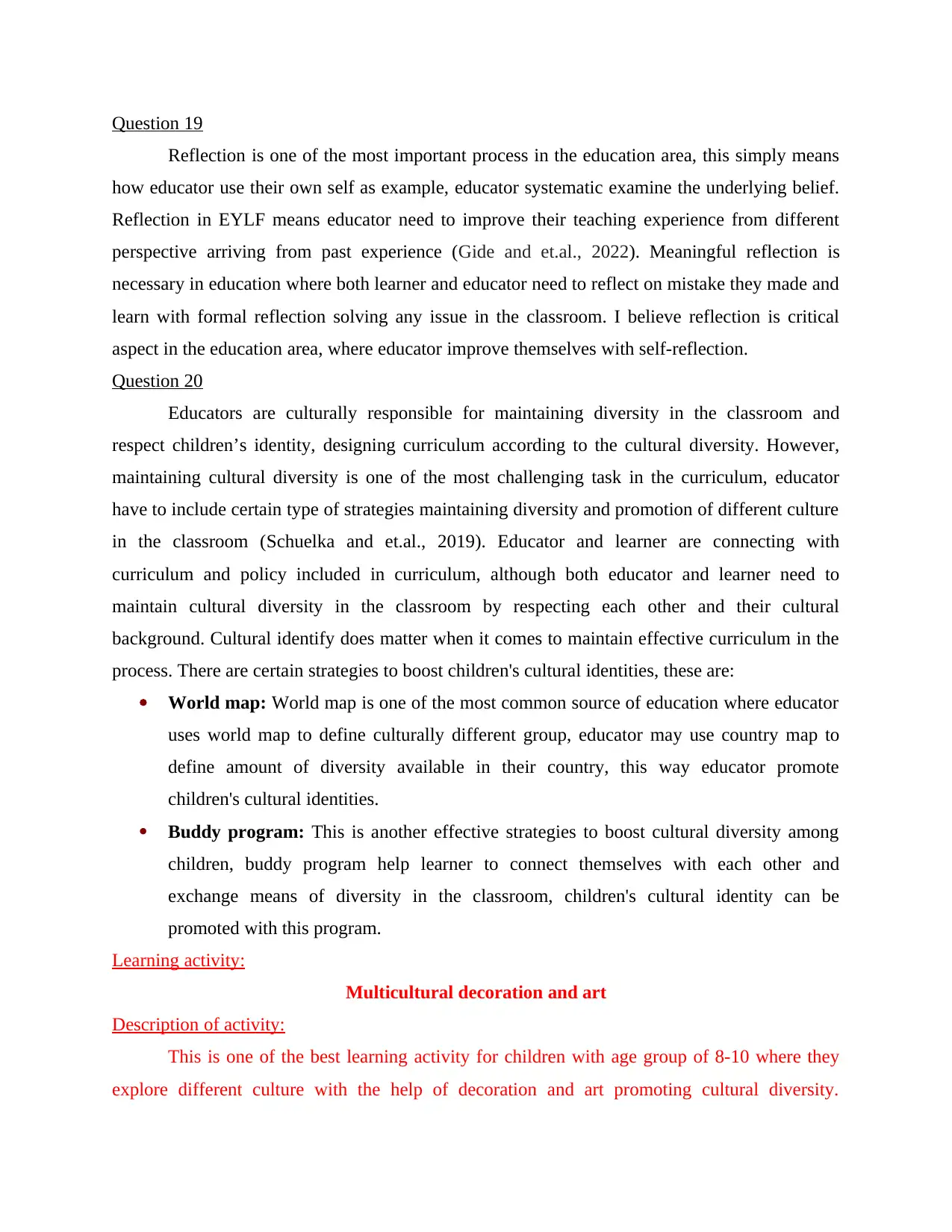
Question 19
Reflection is one of the most important process in the education area, this simply means
how educator use their own self as example, educator systematic examine the underlying belief.
Reflection in EYLF means educator need to improve their teaching experience from different
perspective arriving from past experience (Gide and et.al., 2022). Meaningful reflection is
necessary in education where both learner and educator need to reflect on mistake they made and
learn with formal reflection solving any issue in the classroom. I believe reflection is critical
aspect in the education area, where educator improve themselves with self-reflection.
Question 20
Educators are culturally responsible for maintaining diversity in the classroom and
respect children’s identity, designing curriculum according to the cultural diversity. However,
maintaining cultural diversity is one of the most challenging task in the curriculum, educator
have to include certain type of strategies maintaining diversity and promotion of different culture
in the classroom (Schuelka and et.al., 2019). Educator and learner are connecting with
curriculum and policy included in curriculum, although both educator and learner need to
maintain cultural diversity in the classroom by respecting each other and their cultural
background. Cultural identify does matter when it comes to maintain effective curriculum in the
process. There are certain strategies to boost children's cultural identities, these are:
World map: World map is one of the most common source of education where educator
uses world map to define culturally different group, educator may use country map to
define amount of diversity available in their country, this way educator promote
children's cultural identities.
Buddy program: This is another effective strategies to boost cultural diversity among
children, buddy program help learner to connect themselves with each other and
exchange means of diversity in the classroom, children's cultural identity can be
promoted with this program.
Learning activity:
Multicultural decoration and art
Description of activity:
This is one of the best learning activity for children with age group of 8-10 where they
explore different culture with the help of decoration and art promoting cultural diversity.
Reflection is one of the most important process in the education area, this simply means
how educator use their own self as example, educator systematic examine the underlying belief.
Reflection in EYLF means educator need to improve their teaching experience from different
perspective arriving from past experience (Gide and et.al., 2022). Meaningful reflection is
necessary in education where both learner and educator need to reflect on mistake they made and
learn with formal reflection solving any issue in the classroom. I believe reflection is critical
aspect in the education area, where educator improve themselves with self-reflection.
Question 20
Educators are culturally responsible for maintaining diversity in the classroom and
respect children’s identity, designing curriculum according to the cultural diversity. However,
maintaining cultural diversity is one of the most challenging task in the curriculum, educator
have to include certain type of strategies maintaining diversity and promotion of different culture
in the classroom (Schuelka and et.al., 2019). Educator and learner are connecting with
curriculum and policy included in curriculum, although both educator and learner need to
maintain cultural diversity in the classroom by respecting each other and their cultural
background. Cultural identify does matter when it comes to maintain effective curriculum in the
process. There are certain strategies to boost children's cultural identities, these are:
World map: World map is one of the most common source of education where educator
uses world map to define culturally different group, educator may use country map to
define amount of diversity available in their country, this way educator promote
children's cultural identities.
Buddy program: This is another effective strategies to boost cultural diversity among
children, buddy program help learner to connect themselves with each other and
exchange means of diversity in the classroom, children's cultural identity can be
promoted with this program.
Learning activity:
Multicultural decoration and art
Description of activity:
This is one of the best learning activity for children with age group of 8-10 where they
explore different culture with the help of decoration and art promoting cultural diversity.
⊘ This is a preview!⊘
Do you want full access?
Subscribe today to unlock all pages.

Trusted by 1+ million students worldwide
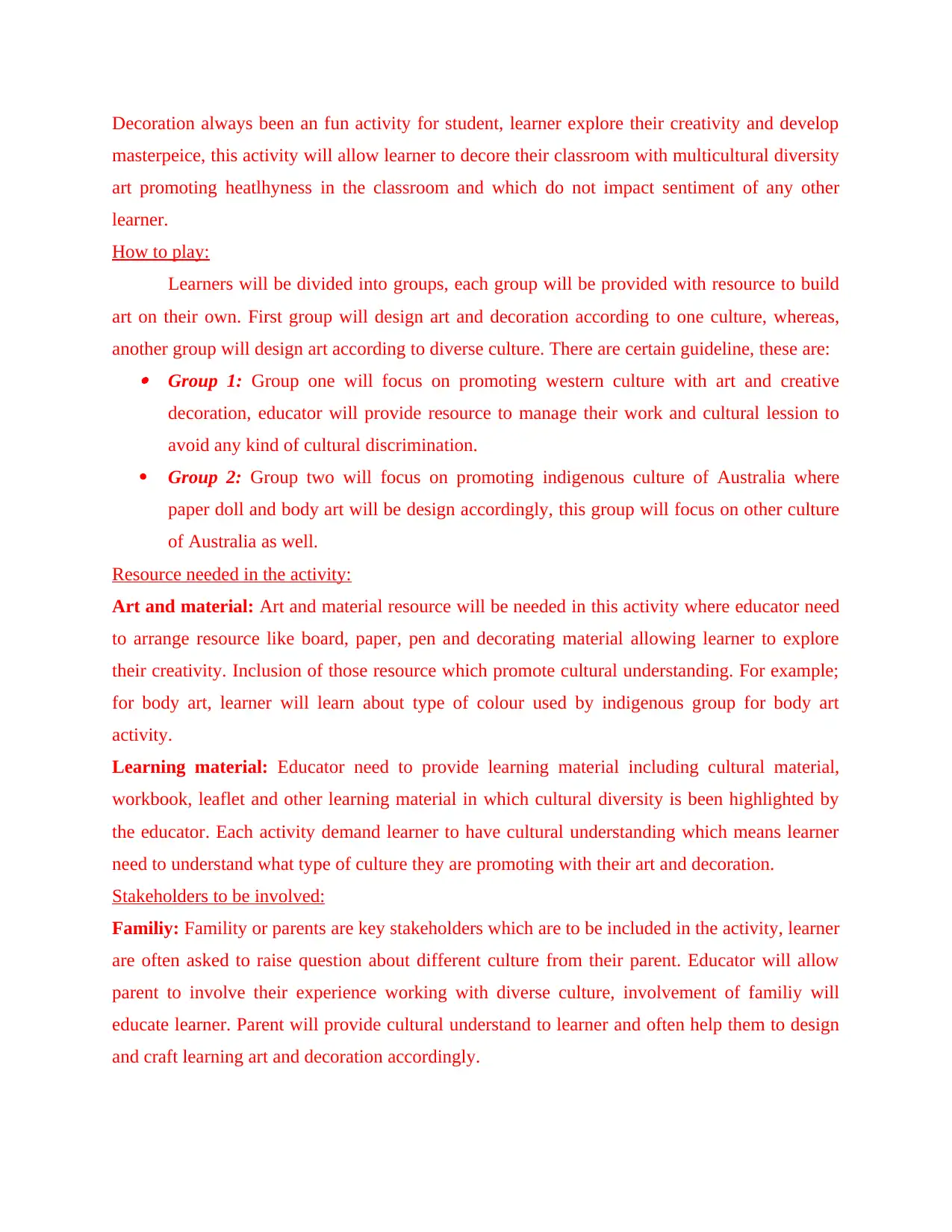
Decoration always been an fun activity for student, learner explore their creativity and develop
masterpeice, this activity will allow learner to decore their classroom with multicultural diversity
art promoting heatlhyness in the classroom and which do not impact sentiment of any other
learner.
How to play:
Learners will be divided into groups, each group will be provided with resource to build
art on their own. First group will design art and decoration according to one culture, whereas,
another group will design art according to diverse culture. There are certain guideline, these are: Group 1: Group one will focus on promoting western culture with art and creative
decoration, educator will provide resource to manage their work and cultural lession to
avoid any kind of cultural discrimination.
Group 2: Group two will focus on promoting indigenous culture of Australia where
paper doll and body art will be design accordingly, this group will focus on other culture
of Australia as well.
Resource needed in the activity:
Art and material: Art and material resource will be needed in this activity where educator need
to arrange resource like board, paper, pen and decorating material allowing learner to explore
their creativity. Inclusion of those resource which promote cultural understanding. For example;
for body art, learner will learn about type of colour used by indigenous group for body art
activity.
Learning material: Educator need to provide learning material including cultural material,
workbook, leaflet and other learning material in which cultural diversity is been highlighted by
the educator. Each activity demand learner to have cultural understanding which means learner
need to understand what type of culture they are promoting with their art and decoration.
Stakeholders to be involved:
Familiy: Famility or parents are key stakeholders which are to be included in the activity, learner
are often asked to raise question about different culture from their parent. Educator will allow
parent to involve their experience working with diverse culture, involvement of familiy will
educate learner. Parent will provide cultural understand to learner and often help them to design
and craft learning art and decoration accordingly.
masterpeice, this activity will allow learner to decore their classroom with multicultural diversity
art promoting heatlhyness in the classroom and which do not impact sentiment of any other
learner.
How to play:
Learners will be divided into groups, each group will be provided with resource to build
art on their own. First group will design art and decoration according to one culture, whereas,
another group will design art according to diverse culture. There are certain guideline, these are: Group 1: Group one will focus on promoting western culture with art and creative
decoration, educator will provide resource to manage their work and cultural lession to
avoid any kind of cultural discrimination.
Group 2: Group two will focus on promoting indigenous culture of Australia where
paper doll and body art will be design accordingly, this group will focus on other culture
of Australia as well.
Resource needed in the activity:
Art and material: Art and material resource will be needed in this activity where educator need
to arrange resource like board, paper, pen and decorating material allowing learner to explore
their creativity. Inclusion of those resource which promote cultural understanding. For example;
for body art, learner will learn about type of colour used by indigenous group for body art
activity.
Learning material: Educator need to provide learning material including cultural material,
workbook, leaflet and other learning material in which cultural diversity is been highlighted by
the educator. Each activity demand learner to have cultural understanding which means learner
need to understand what type of culture they are promoting with their art and decoration.
Stakeholders to be involved:
Familiy: Famility or parents are key stakeholders which are to be included in the activity, learner
are often asked to raise question about different culture from their parent. Educator will allow
parent to involve their experience working with diverse culture, involvement of familiy will
educate learner. Parent will provide cultural understand to learner and often help them to design
and craft learning art and decoration accordingly.
Paraphrase This Document
Need a fresh take? Get an instant paraphrase of this document with our AI Paraphraser
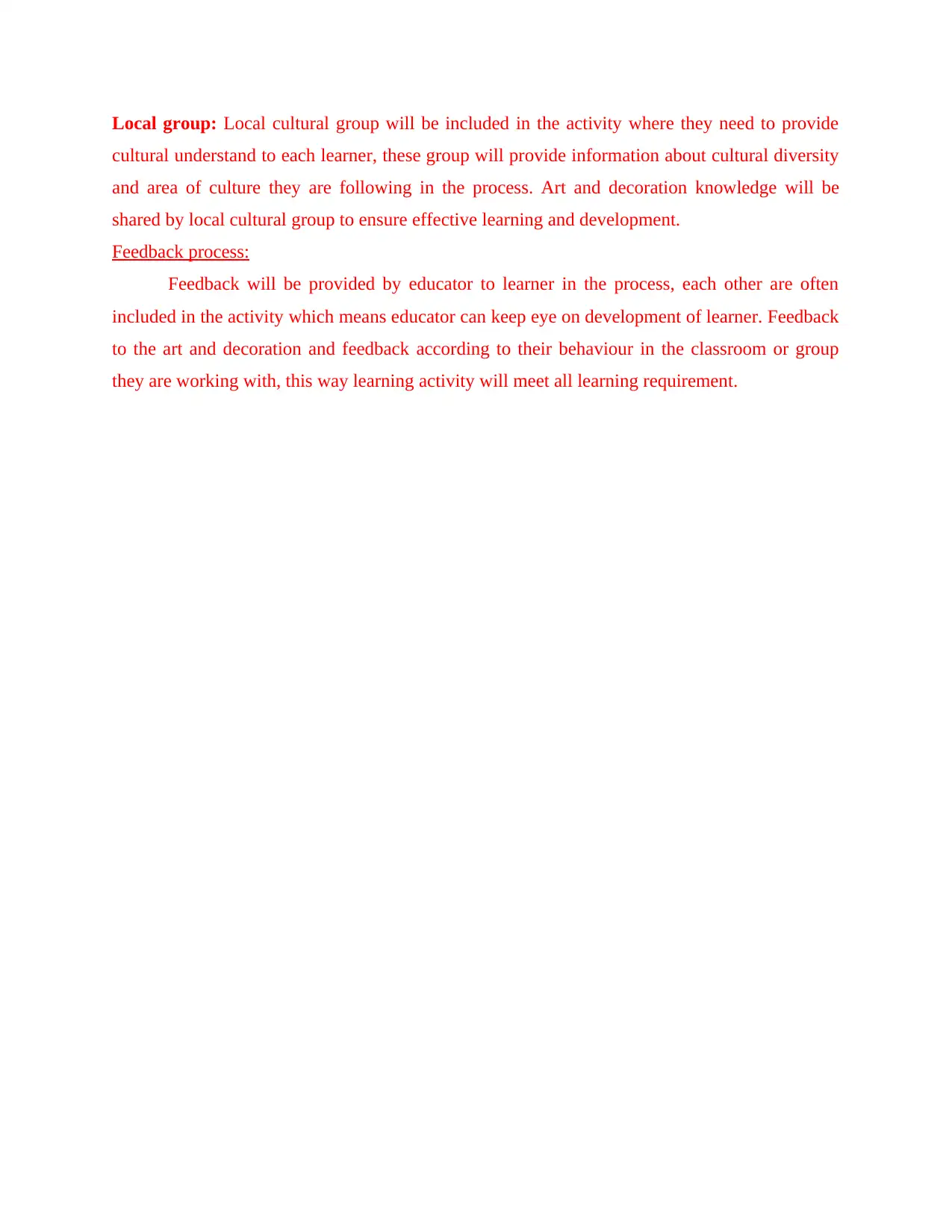
Local group: Local cultural group will be included in the activity where they need to provide
cultural understand to each learner, these group will provide information about cultural diversity
and area of culture they are following in the process. Art and decoration knowledge will be
shared by local cultural group to ensure effective learning and development.
Feedback process:
Feedback will be provided by educator to learner in the process, each other are often
included in the activity which means educator can keep eye on development of learner. Feedback
to the art and decoration and feedback according to their behaviour in the classroom or group
they are working with, this way learning activity will meet all learning requirement.
cultural understand to each learner, these group will provide information about cultural diversity
and area of culture they are following in the process. Art and decoration knowledge will be
shared by local cultural group to ensure effective learning and development.
Feedback process:
Feedback will be provided by educator to learner in the process, each other are often
included in the activity which means educator can keep eye on development of learner. Feedback
to the art and decoration and feedback according to their behaviour in the classroom or group
they are working with, this way learning activity will meet all learning requirement.
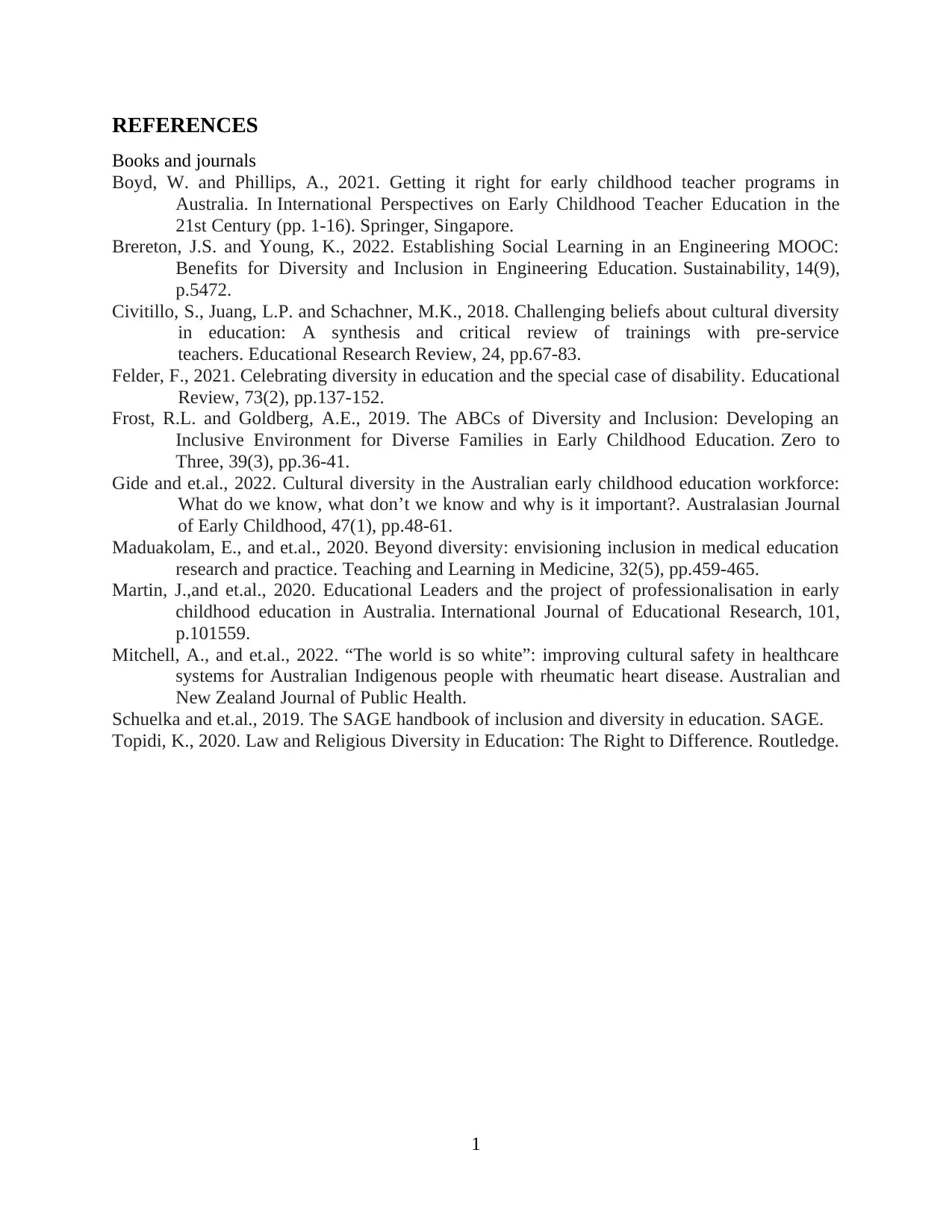
REFERENCES
Books and journals
Boyd, W. and Phillips, A., 2021. Getting it right for early childhood teacher programs in
Australia. In International Perspectives on Early Childhood Teacher Education in the
21st Century (pp. 1-16). Springer, Singapore.
Brereton, J.S. and Young, K., 2022. Establishing Social Learning in an Engineering MOOC:
Benefits for Diversity and Inclusion in Engineering Education. Sustainability, 14(9),
p.5472.
Civitillo, S., Juang, L.P. and Schachner, M.K., 2018. Challenging beliefs about cultural diversity
in education: A synthesis and critical review of trainings with pre-service
teachers. Educational Research Review, 24, pp.67-83.
Felder, F., 2021. Celebrating diversity in education and the special case of disability. Educational
Review, 73(2), pp.137-152.
Frost, R.L. and Goldberg, A.E., 2019. The ABCs of Diversity and Inclusion: Developing an
Inclusive Environment for Diverse Families in Early Childhood Education. Zero to
Three, 39(3), pp.36-41.
Gide and et.al., 2022. Cultural diversity in the Australian early childhood education workforce:
What do we know, what don’t we know and why is it important?. Australasian Journal
of Early Childhood, 47(1), pp.48-61.
Maduakolam, E., and et.al., 2020. Beyond diversity: envisioning inclusion in medical education
research and practice. Teaching and Learning in Medicine, 32(5), pp.459-465.
Martin, J.,and et.al., 2020. Educational Leaders and the project of professionalisation in early
childhood education in Australia. International Journal of Educational Research, 101,
p.101559.
Mitchell, A., and et.al., 2022. “The world is so white”: improving cultural safety in healthcare
systems for Australian Indigenous people with rheumatic heart disease. Australian and
New Zealand Journal of Public Health.
Schuelka and et.al., 2019. The SAGE handbook of inclusion and diversity in education. SAGE.
Topidi, K., 2020. Law and Religious Diversity in Education: The Right to Difference. Routledge.
1
Books and journals
Boyd, W. and Phillips, A., 2021. Getting it right for early childhood teacher programs in
Australia. In International Perspectives on Early Childhood Teacher Education in the
21st Century (pp. 1-16). Springer, Singapore.
Brereton, J.S. and Young, K., 2022. Establishing Social Learning in an Engineering MOOC:
Benefits for Diversity and Inclusion in Engineering Education. Sustainability, 14(9),
p.5472.
Civitillo, S., Juang, L.P. and Schachner, M.K., 2018. Challenging beliefs about cultural diversity
in education: A synthesis and critical review of trainings with pre-service
teachers. Educational Research Review, 24, pp.67-83.
Felder, F., 2021. Celebrating diversity in education and the special case of disability. Educational
Review, 73(2), pp.137-152.
Frost, R.L. and Goldberg, A.E., 2019. The ABCs of Diversity and Inclusion: Developing an
Inclusive Environment for Diverse Families in Early Childhood Education. Zero to
Three, 39(3), pp.36-41.
Gide and et.al., 2022. Cultural diversity in the Australian early childhood education workforce:
What do we know, what don’t we know and why is it important?. Australasian Journal
of Early Childhood, 47(1), pp.48-61.
Maduakolam, E., and et.al., 2020. Beyond diversity: envisioning inclusion in medical education
research and practice. Teaching and Learning in Medicine, 32(5), pp.459-465.
Martin, J.,and et.al., 2020. Educational Leaders and the project of professionalisation in early
childhood education in Australia. International Journal of Educational Research, 101,
p.101559.
Mitchell, A., and et.al., 2022. “The world is so white”: improving cultural safety in healthcare
systems for Australian Indigenous people with rheumatic heart disease. Australian and
New Zealand Journal of Public Health.
Schuelka and et.al., 2019. The SAGE handbook of inclusion and diversity in education. SAGE.
Topidi, K., 2020. Law and Religious Diversity in Education: The Right to Difference. Routledge.
1
⊘ This is a preview!⊘
Do you want full access?
Subscribe today to unlock all pages.

Trusted by 1+ million students worldwide
1 out of 12
Related Documents
Your All-in-One AI-Powered Toolkit for Academic Success.
+13062052269
info@desklib.com
Available 24*7 on WhatsApp / Email
![[object Object]](/_next/static/media/star-bottom.7253800d.svg)
Unlock your academic potential
Copyright © 2020–2025 A2Z Services. All Rights Reserved. Developed and managed by ZUCOL.
![Diploma in Early Childhood Education Assignment - [University Name]](/_next/image/?url=https%3A%2F%2Fdesklib.com%2Fmedia%2Fimages%2Fim%2F9ec57b9d282b457796267c3de395758c.jpg&w=256&q=75)




